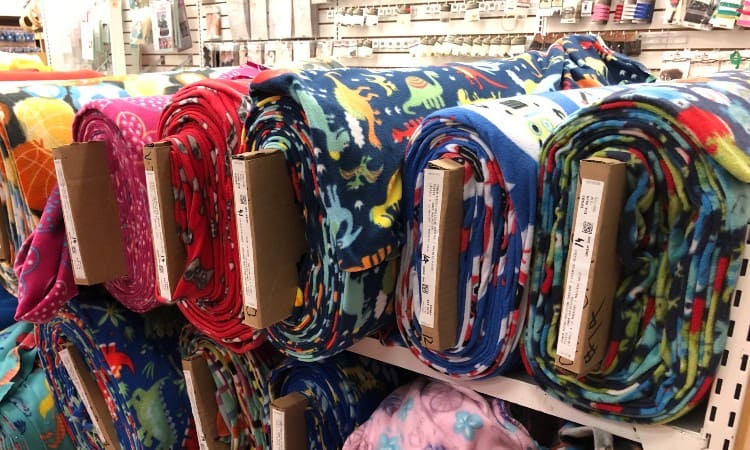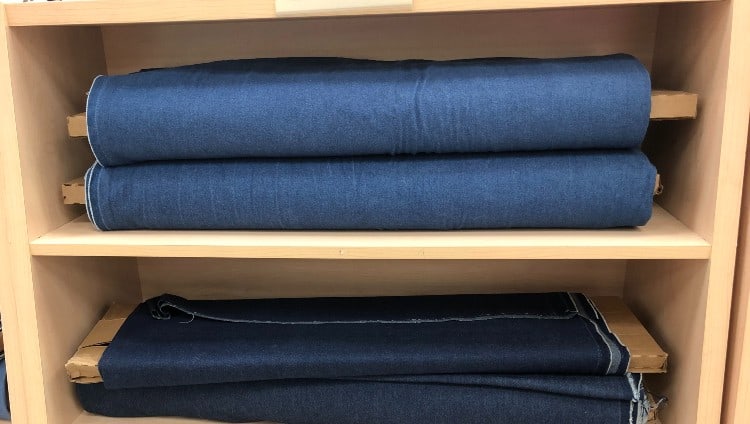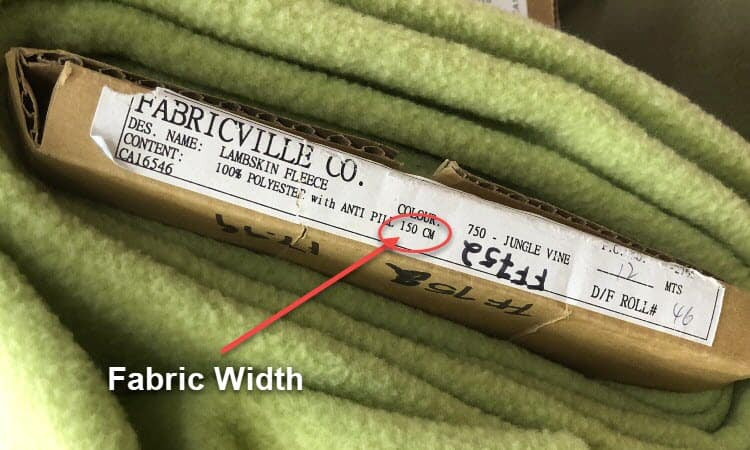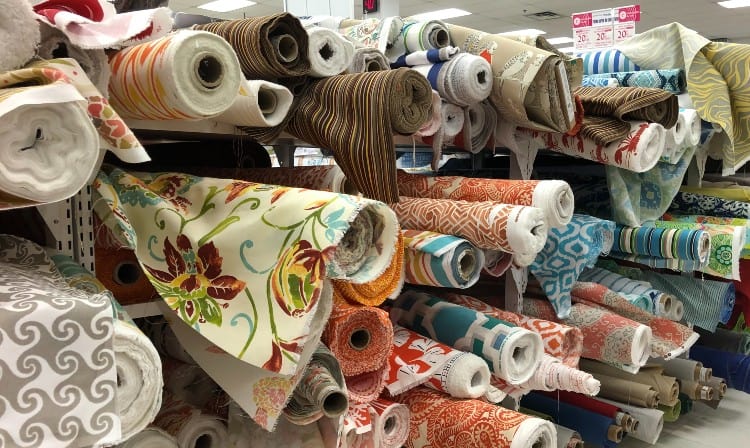What Size Is A Yard Of Fabric
Standing in the textile store surrounded past bolts of gorgeous colors tin can be exciting – or intimidating. How can you make certain you have enough material for your next project before you're standing at your cutting table? The key to answering this question is knowing the width of cloth you have available to you.
The standard width of a cloth bolt tin can be anywhere from 35 inches to 108 inches. The average commodities will autumn within the 40 to 60-inch range, with specialty fabrics falling on the outer reaches of the range. Until you know the width of your fabric, you won't know how many yards you need.
The best way to find the width of your fabric is to measure it on a flat surface. Before you become that far, however, you can estimate the width based on factors like the type of material, where y'all're ownership, and how the material is folded on the commodities. This guide will take you from a textile width novice to a measurement whiz!

What Is the Width of Fabric (WOF)?
The width of the fabric or WOF refers to the distance between the outermost warp threads. When y'all manufacture fabric on a loom, in that location are threads running in two directions, the warp and the weft. If you call back of the fabric like a large filigree, the warp threads run top to lesser, and the weft threads run left to right.
The usable width of your fabric is the measurement between the warp thread on the left edge to the warp thread on the correct edge, minus whatever selvage. The actual piece of material could be wider than the usable portion, but most manufacturers will provide the usable width rather than the bodily width.
In sewing, the WOF is the corporeality of space you accept to place your pattern pieces between selvage edges. You want to cut within that boundary because selvage edges are denser than the rest of the fabric, so including them in a pattern piece can brand your garment crease.
For quilting, WOF can include the selvage edges. This is because you generally aren't using pattern pieces to cut out quilt cloth. A quilting education similar "cut out a four-inch WOF strip" would mean to cut 1 strip of fabric, including selvage edges.
Why Is Fabric Width Important?
Fabric width is important considering it volition help you determine how many yards of fabric you lot'll need to complete your pattern. For instance, if you lot take a quilting pattern that calls for v yards of a fabric with a WOF of 45 inches, but y'all want to employ a fabric that has a shorter WOF, y'all'll know you need more than than 5 yards to complete the pattern.
Most patterns for sewing or quilting projects will give y'all both a yardage requirement and a WOF measurement. Knowing these two measurements is the only mode to guarantee yous'll have the right amount of fabric for your project before y'all offset cutting.
How to Measure out the Width of Fabric
Measuring the width of your fabric is easy – all y'all need is a big flat surface and a yardstick or other measuring tool. Lay your fabric out flat, smoothing out whatever wrinkles. Make certain yous've unfolded information technology and so that you can see both selvage edges. Place one stop of your yardstick on one selvage edge and notation where the number where the other selvage edge touches.
If you utilise a cutting mat with measurements printed on it, you can lay out your fabric there to check the measurements. Measuring tapes piece of work too, but a stiff tool like a yardstick is more than probable to give you an accurate measurement every fourth dimension.
To bank check the usable width between selvage edges, adjust the position of your yardstick and so that the nix is lined up with the start of the usable textile. Most fabrics will be less than a g beyond, but for wider fabrics similar quilt bankroll or upholstery, you may need to use multiple yardsticks or a big cutting mat to measure your WOF.
What Is the Standard Width of Fabric Bolt?

Fabric width varies past manufacturer and fabric type. While there isn't a standard width for all fabric bolts, at that place are ways to estimate how broad fabric is earlier yous mensurate it. Similar fabrics tend to accept like widths; for example, most cotton fabrics take the same width whereas about wools have the same width, but wool and cotton won't necessarily have the aforementioned width equally each other.
The average width for cloth yous'd find in a local arts and crafts shop or fabric store is between 40 and threescore inches. When you run across fabric rolled up on rectangular cardboard bolts, it'due south prophylactic to assume that the width is going to fall somewhere between 35 inches and 108 inches. Knowing the kind of textile volition help you make a closer guess.
What Is Single Width Textile?
Single-width fabric refers to any fabric that's wrapped around the bolt unfolded. When yous unroll a single-width fabric, you'll only accept one layer on your cut table. The selvage edges will exist on opposite sides of the cloth, and you'll be able to clearly see the correct and wrong sides of the fabric. Unmarried-width fabric is usually wrapped around the bolt with the right side facing outwards, then you can see it.
What Is Double Width Fabric?
Double width fabric is a fabric that is folded in half widthwise earlier the manufacturer wraps it around the bolt. When you unwrap this fabric, the selvage edges will be on the same side, and the opposite side will take a fold.
This is how extremely wide fabrics like upholstery or drapery fabrics are packaged. Typically, the correct side of the fabric will confront outwards, and the wrong sides will be facing each other inside the fold. When y'all cut this fabric off the bolt, you'll have a double layer.
Fabrics with Narrow Widths
Narrow fabrics tend to be materials that you utilize for smaller pieces, like interfacing. You don't need every bit much width, then bolts of interfacing tend to be closer to xxx inches than twoscore. Vintage fabrics, specially cottons and muslins, also tend to be narrower than twoscore inches.
Smaller looms lead to narrower fabrics, so fabric manufactured outside of a commercial setting is more than likely to be narrow. These fabrics are mostly older, or more than specialty. It is rare to find these fabrics in your average fabric store.
Fabrics with Average Widths
The vast majority of fabrics that you'll detect today will autumn within the forty to 60-inch range. Quilting cotton fiber and about dress fabric fit these parameters. Within this range, quilting fabrics tend to be larger than others.
Cotton wool is typically a few inches wider than flannel, and wool is usually a few inches wider than cotton. All of these, however, will exist unmarried-width fabrics. If you lot find an apparel fabric that'south folded double on the bolt, it'south going to be an extra wide fabric.
Wider than Average Fabrics (Extra Wide Fabric)
The nigh common extra wide fabrics are for upholstery and home decor. These fabrics tend to be packaged as double width because they're so broad. They are typically between 54 inches and 108 inches wide. Dwelling house decor fabrics with intricate patterns like brocades are usually extra wide to reduce the need for pattern matching and seaming on large items, like couches or drapes.
Some less common apparel fabrics besides show upwardly in extra wide widths. Knit bailiwick of jersey, corduroy, and twill skew wider, because of the style they're fabricated. Knit jersey is more likely to exist sold double width than corduroy, however, because it is easier to fold.
Quilt backing is also normally sold in extra wide widths. Backing an entire quilt in one seamless piece of material usually requires more 60 inches in width. A standard queen-size bed is 60 inches across, so making quilts to fit annihilation larger than a queen requires wider quilt backing.
How to Find the Width of Material Bolts

Before you lot pull downward a bolt and roll it out to cut, it'southward a practiced thought to try to detect the width. That volition aid y'all calculate how many yards you'll need, and whether the fabric tin conform your pattern.
If the textile is wrapped effectually a rectangular cardboard bolt, check the end of the paper-thin for a characterization. Almost cardboard bolts volition take a sticker with information well-nigh the fabric, including the WOF, fiber content, and washing instructions. Depending on the retailer, this characterization could also include pricing per one thousand information.
If the fabric is on a roll or the cardboard bolt is blank, cheque for a hanging tag or some other label nearby. The tag should contain all of the aforementioned information that the bolt would.
Proceed in mind that the yardage the label states may not be accurate, specially if someone else has already purchased some of the bolt. Always measure the fabric earlier cutting or purchasing the bolt. Mensurate twice, cut once applies from the very outset of your project!
Does the Width Modify How Many Yards Are On a Bolt?
The WOF doesn't have a huge influence on how many yards are wrapped around a bolt. The average bolt has between twoscore and 100 yards, to begin with, regardless of the width. The thickness of the fabric has more than impact on the yardage than the width.
Thicker material volition take less yardage length than thinner textile because information technology is harder to wrap around the bolt every bit many times. Denim will go likewise thick for the cardboard bolt before a cotton fiber/lycra blend volition.
When you're ownership an entire bolt of material, brand sure to measure information technology even if the dimensions are printed on the label. Especially in retail chains, you may not be able to tell if someone else has purchased role of the bolt or not. Information technology'southward ameliorate to accept the time to measure out your fabric in the store than to go home and outset cutting, simply to realize you're short a few yards!
Is a Commodities Measured the Same Way equally a Gyre?

When you lot're buying fabric wholesale, or from a large outlet, you might notice that the fabric isn't folded onto bolts. Rather, it's rolled upwardly on tubes, like wrapping paper. Rolls of fabric aren't measured the aforementioned way as bolts.
Extra broad fabric can be put on rolls in a single layer instead of folded double over bolts. This is useful for thicker, less flexible fabrics that won't fold equally neatly. Rolls are a more than common practice for wholesalers because they are dealing with larger quantities at a fourth dimension. Selling 250 yards cut from a single scroll is easier than selling that much in 40-yard bolts.
How Wide Is Cloth Sold by the Yard?
Fabric is normally sold by the one thousand, no affair how broad information technology is. The price per yard should account for the width of the textile, also. For instance, double width cloth might look like it costs double per yard as a similar fabric sold single width. Really, the price per foursquare pes is likely the same, you just get twice as much fabric per yard in double width as y'all practice in a single.
"Past the g" is a shorter style of noting the size of material than labeling textile by foursquare anxiety or square inches. Selling it by lengths and providing you with widths is a way to give you more data near the fabric than other means of measuring it.
How to Make Sure You Get Enough Cloth
Knowing the width is the first pace in getting enough fabric for your project. One time you know this information, there are a few more things to look at to make certain you don't end upward short-changing yourself.
Look at your pattern to see how you'll need to cutting out your pieces. For quilting, double cheque that the fabric tin accommodate the widest pieces of your pattern. For sewing, look at the lengths of the individual pattern pieces. A width that works for a blouse, for example, may not work for a full circle skirt.
Brand sure to check the selvage edge of the fabric when you're making your calculations. Even a little overlap with the selvage could brand constructing your design hard if there'southward a huge difference in fabric density.
At the same time, brand sure y'all take plenty textile to business relationship for fussy cuttings or lining up directional prints. While you might be able to get enough fabric out of 3 yards of striped textile, that may not be enough fabric to line up the stripes so that they are all facing the right direction. Given the choice between buying extra fabric and having kleptomaniacal stripes or plaids, information technology's better to have extra fabric!
Fabric Width Conversion Chart
Figuring out how much fabric yous need when your pattern width and your fabric width don't lucifer can be tricky. Apply the chart below as a handy guide for converting the yardage for various fabric widths. The nearly common yardage requirements are listed.
Ever err on the side of getting actress textile, particularly if y'all're working with directional prints or hard-to-find fabrics. The largest yardage on this chart is 2 yards of 60-inch textile, only the conversion is the aforementioned for any yardage; simply swap the whole number for the yardage you need (i.due east. if you need four yards of 60 inch, you could use 4 ¾ yards of 35 inch).

Determination
Fabric comes in a diversity of widths, based on the type of cloth and its intended utilise. Fifty-fifty though there is a variety, there are easy tricks to figuring out the correct corporeality of yardage for your project. Knowing the width of your fabric is the first step for making the perfect project.
If y'all found these tips helpful for your sewing and quilting projects, please let us know in the comments! Share this article to help others acquire well-nigh the importance of fabric widths and measuring your fabric accurately.
What Size Is A Yard Of Fabric,
Source: https://silverbobbin.com/width-of-fabric/
Posted by: millerdidettioners.blogspot.com


0 Response to "What Size Is A Yard Of Fabric"
Post a Comment